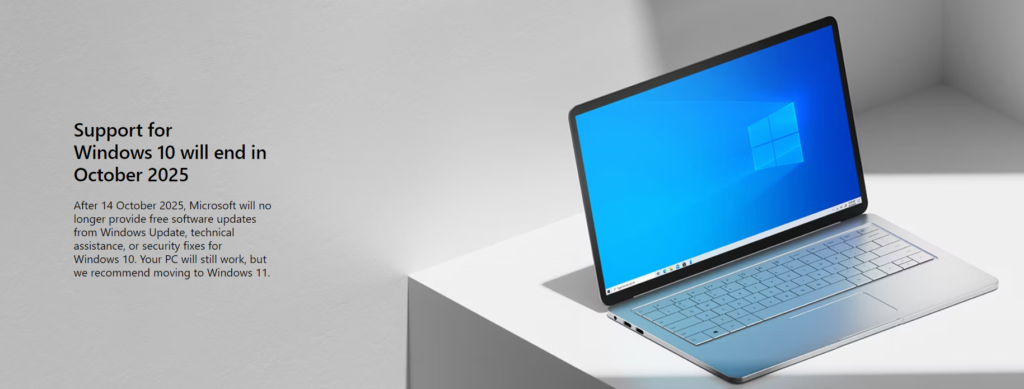
The End of Life (EOL) designation means that Microsoft will cease delivering security patches, bug fixes, and any form of technical assistance for Windows 10. While your computer will still operate after this date, it will no longer receive critical updates that protect it from new vulnerabilities, malware, and other cybersecurity threats. Over time, this will make systems running Windows 10 increasingly unsafe in the face of evolving cyberattacks.

Microsoft has a history of providing support for its operating systems over a set lifecycle. Windows 10 was initially released in 2015 with a commitment to a 10-year support lifecycle. During this period, the company has regularly provided updates, including major feature releases and security patches. However, with the launch of Windows 11 in October 2021, Microsoft has shifted its development and support efforts to the latest version of its operating system.
Ending support for Windows 10 allows Microsoft to streamline its resources and encourage users to transition to Windows 11 or other platforms that offer enhanced security, modern features, and better integration with cloud services and the latest hardware.
After October 14, 2025, the following will occur for Windows 10 users:
Your system will become more vulnerable to malware, ransomware, and other security threats as new vulnerabilities are discovered but left unpatched.
Any bugs or glitches in Windows 10 will no longer be addressed, potentially leading to a degraded user experience over time.
If you encounter any issues with Windows 10, Microsoft’s technical support team will no longer assist you, and you will need to rely on third-party support or forums.
As third-party developers focus on newer operating systems, some software, drivers, and apps may no longer be compatible with Windows 10, limiting the usability of your system.
With the EOL deadline in place, it’s essential to start planning for your transition away from Windows 10. Here are some steps to consider:
The most straightforward option for many users is upgrading to Windows 11. Microsoft’s latest OS comes with a host of new features, improved security, and better performance. However, not all Windows 10 PCs will meet the hardware requirements for Windows 11, which include support for TPM 2.0 (Trusted Platform Module), Secure Boot, and a compatible 64-bit processor.
You can check if your device is eligible for the upgrade using Microsoft’s PC Health Check tool, which is available on their website. If your device qualifies, upgrading to Windows 11 will ensure that you receive continued updates and support.
For users whose current hardware is not compatible with Windows 11, it may be time to consider purchasing a new device. Modern PCs are designed to work with the latest operating systems, offering improved security, faster performance, and better support for productivity tools. When shopping for a new device, look for models that are specifically designed for Windows 11, as these will offer the best experience.
If you are not ready or willing to upgrade to Windows 11, you could consider switching to an alternative operating system like Linux or macOS (if you’re considering new hardware). These systems offer robust security and are actively supported by their respective communities or vendors. However, be aware that switching to a new operating system may come with a learning curve and compatibility considerations.
Before making any changes to your system, it’s essential to back up all of your important data. Use external hard drives or cloud storage solutions like OneDrive, Google Drive, or Dropbox to ensure that your documents, photos, and other files are safely stored. If you’re upgrading or migrating to a new OS, make sure to verify that your data has been properly transferred.


If you’re unable to upgrade or transition before the EOL date, there are a few things you can do to minimize risk:
Try to avoid using your system for sensitive tasks like online banking or accessing personal information.
Consider installing third-party antivirus and anti-malware solutions to provide some level of security.
If possible, keep the device offline to reduce exposure to potential security risks.
The end of support for Windows 10 marks the beginning of a new chapter in Microsoft’s operating system evolution. With October 14, 2025, fast approaching, it’s crucial for users to assess their options and prepare for the transition. Whether upgrading to Windows 11, purchasing new hardware, or exploring alternative systems, making a proactive plan will ensure that you stay secure and continue enjoying a smooth, supported computing experience.
For more information and resources, visit Microsoft’s End of Support page.

Senior Account Manager
As a Senior Account Manager at alltasksIT, Kevin brings over 20 years of diverse IT experience and deep expertise in cloud solutions.
With his extensive technical background, coupled with his experience in cloud product management and forward-thinking mindset, Kevin Carne is a valuable asset to alltasksIT.